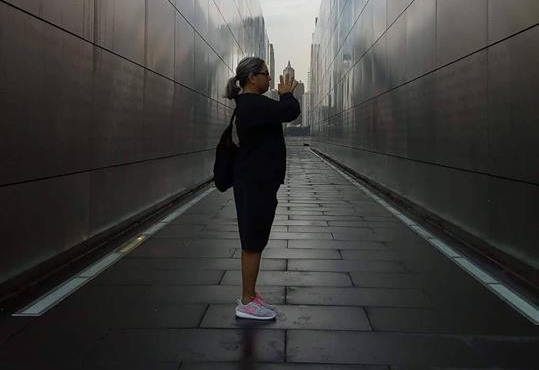The expression used in the title is a Portuguese expression that means something like: “Facilitate the way to achieve a goal” or “help someone to achieve an objective unfairly”.
How does Shorinji Kempo come into your life?
My father (Sensei Fausto Carriço) had been training for some time, and I was going to see his training. I asked to start, at first he did not leave me, then I hid behind the curtain doing what they did in the dojo, had to give in and let me train (laughs)
Tell us what it is like to go to Hombu, how did you feel the first time you were there?
This question makes me smile because I still remember what I felt …
A shiver through the body, a dazzle for space, and the sense of harmony in the air, of positive energies that cradle us in our looks, in walking, in training.
It is a magical place just because it exists.
Getting to the gates and feeling that everything really makes sense, everything fits into a balance,
But the magic of this is that the sensation is always the same, the wonder is always the same.
It is a resolution of emotions, time stops, I tried to savor every moment, every smell, every photograph, every painting, every dojo.
Everything is a motivational explosion factor.
Sensei Cristina, how can I describe it?
A charitable person, friend of helping others (as Shorinji Kempo teaches), demanding as all Shorinji Kempo kenshi know, but always with love and care in the heart.
My thanks to my teacher, who gave me the wisdom to be who I am today.
The one that stoned me with caprices and attention so that today I could be proud. I thank my teacher, who taught me how to be the human being that I am today.
Thank you Sensei Cristina Carriço
Miguel Horta
Do you feel an increased responsibility for being the daughter of one of the most senior Sensei (Fausto Carriço) in Portugal? Have you ever felt any difficulty because of it?
Honestly no. My entire course at Shorinji Kempo was made with hard work and resilience, regardless of kinship, when I started training I was the only girl and the only child (in the dojo where I trained), unjustly, no, it just annoyed me that my presentation is always made, added to my father (for example, it is the daughter of the Sensei Fausto instead it is the Sensei Cristina), it took some time, but at this point each one has its space well defined (laughs ).
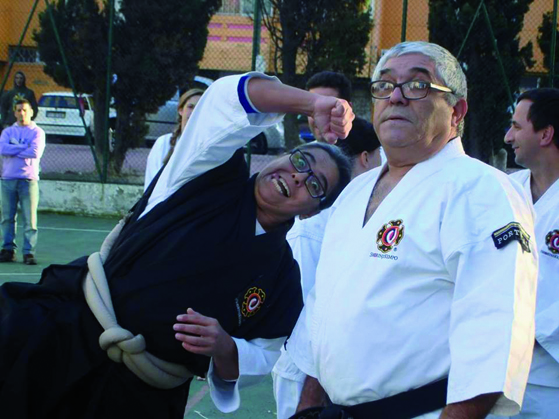
Why did you dedicate yourself more to the Shorinji Kempo over the gym?
(laughs) Gymnastics comes as a challenge by the end of my teenage years, I liked it, but what filled me up was always the Shorinji Kempo, but it was important to boost physical abilities.
What were the two most striking moments that will last forever?
Good, I’m lucky to be some, the ones who marked me, but, I can tell you, the day I met Ms. Yuki So, and I received the congratulations for the kumi embu I had performed, the legs trembled like green sticks, the mouth he was dry with so many nerves; and train with Sensei Arai and Sensei Yamazaki, each with its own particularities but that promote a fabulous technical symbiosis.
Shorinji Kempo is a wonderful martial art that taught me self-defense and strong self-esteem improving my person.
Shorinji Kempo also gave me the opportunity to meet many people with whom I have created excellent friendships and one of these people is Sensei Cristina Carriço. She is a special person, always with a big smile on her face and with a very strong character. Always ready to help and give very good and valuable advice.
We were rivals, participating in the “man-woman” category in many Taikai, but at the end of Taikai, a strong embrace was immediately ready between us, which still unites us today.
We reviewed and trained together many times in Japan and Europe (Montecarlo, Messina, Lisbon). The last time we met, personally, was in San Francisco last year, and I hope to have the pleasure of meeting again on the mat to train and have fun together.
Angela Zucco
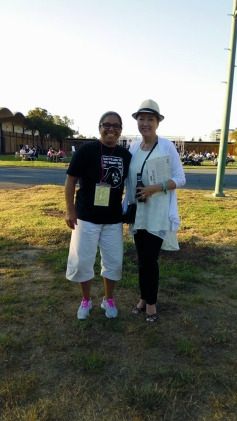 When did you stop being Sempai and started to be Sensei? What changes did that make in your perspective regarding our practice?
When did you stop being Sempai and started to be Sensei? What changes did that make in your perspective regarding our practice?
Well, if we go to school, it’s in 2002 (Xabregas, with Carlos Henriques), but my process as a “teacher” started long before that, in the section of Sensei Fausto, who was also and my teacher in 1997, already was taking the Physical Education course, which empowered him to assume teaching functions in the various schools. Regarding my perspective, little changed because the seriousness with which he faced the training remained, as a transmitter of knowledge, increases responsibility, because in a more direct way we become an example for those around us. As for the perspective, it is the same, with an unshakable passion, in the practice and promotion of Shorinji Kempo.
Has it ever occurred to you to give up Shorinji Kempo? If so, how did you find the strength and will to continue?
I was stopped for some time, the reasons, at this point, do not matter, giving relevance to what caused the withdrawal, would be a way to feed something that is not good and give prominence to what caused it. I came back for the nostalgia and by that time I was instigated, in a good way, to return, and above all because my father already had his Branch and I would only train with him at that time.
When I was asked if I could write a short text about Sensei Cristina Carriço for Jornal Gassho Sintra, I answered: “Of course – it will be an honor for me”.
I do not remember when we met for the first time – probably a long time ago.
I’ve seen her play Embu on several occasions and I’ve always been surprised.
I think your great example is to give inspiration to all kenshi women to study and run the embu.
We have met in various international and Taikai study sessions for years.
But in the year 2015 and in the European Taikai, in October, in Lisbon, Portugal became special. I had been given permission to take the 5th Dan exam at that seminary. I studied hard in my branch. The challenge was that I did not have an undergraduate partner in either Jyväskylä or Finland.
I heard that Cristina would also be present for the exam and we started talking on Facebook. I shared my concern with her and she said that she was not worried, we would be partners because she did not have anyone either.
We met in the morning of the day, when she came to pick me up at the hotel. We did kumi training a couple of times and we agreed on a few things before the exam started.
And everything went well. It was a great feeling – like doing techniques with a longtime partner – old friends.
This exam experience has created a bond that will never break. I hope we meet again soon.
For my graduation partner, Cristina.
Timo Mäki-Kuutti
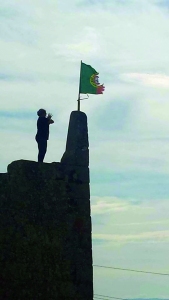 You graduated from 3rd Dan at a time when it was not normal for women to go that far in terms of graduation. Did you feel any difficulties or dismay at being a woman in the “middle of so many men”?
You graduated from 3rd Dan at a time when it was not normal for women to go that far in terms of graduation. Did you feel any difficulties or dismay at being a woman in the “middle of so many men”?
The difficulty is related to the isolation, if you understand me, knowledge does not have sex (laughs), the practice continues to promote the consolidation of learning, I assure you that if you were not in perfect condition to take the exam, Sensei Fausto , I would never have proposed, all that I was achieving was merit and I was never taken in the lap for anything, when our position is transparent and suitable we cannot feel dismay for being who we are and achieving goals like our fellow kenshi men. But it was a hard work, just like any achievement that you pay dearly (laughs).
But then there were some women to train, it was not a desert like in the early 1980s, we were gradually evolving.
Being a female Sensei of Shorinji Kempo and having very few worldwide, have you ever felt you had to prove your worth as a Sensei and Branch Sensei?
Worldwide there are some, fortunately, in Europe only two women 5th Dan (if I am not mistaken) and two women branch master, myself and a 3rd Dan. When practicing a martial art, where the population is predominantly masculine, when someone of the opposite sex becomes evident in some way, (graduation, responsibility), it is strange. But that does not bother me, when you do things with responsibility, commitment and transparency, our space is being won and recognized, if it were easier if we were more, certainly, that would have another expression. I have never had to impose anything or anyone, I have confidence in my abilities, knowledge and skills, which in themselves are the best answer to any dubious situation.
I always had a great respect for Sensei Cristina, for the joyful way of facing life and Shorinji Kempo, for the passion and the commitment to face training and competitions. It was an honor for me to be your partner for the 5th exam. Dan.
Giosuè di Novo
What is your opinion on the new rules imposed by the WSKO with regard to mixed pairs in competition? Do you think they could take the Kenshi away from competitions?
In addition to distorting competition, it is against the law of equality, it is up to each one to decide what is best for them. It does not make much sense, if they tell me it’s because of the projections, a female pair also performs them and the impact is no different. We are in the 21st century and gender equality is already a certainty, at least in Europe, which is the continent I know best, the history of several countries, and the process of emancipation of women. What I feel about these new rules, it’s like trying to balance a balance with one-sided weights. My opinion is based on my experience, but if I present scientific studies with a representative sample of the entire female kenshi population in the world, where it is proved that the impact of the projections causes permanent damage / injury, I will be the first to advocate the measure, but is it only in women? What about men? That’s the point.
However, I would like to raise another question here, it will not be more dangerous the blows to the head, even with the helmets, some study has already been made regarding the danger of the impacts, often violent, (by force and speed), the sequels that can give.
Yes, it worries me.
Kenshi, I do not know, depends on the motivation to perform the kumi embu, who likes to always participate, even if it is for the conviviality, for the specific training, is a unique experience in the practice of Shorinji Kempo, providing sensations that only understands who has participated in international events.
It is rare that Kenshi does not know or know the name of Sensei Cristina. This in itself already says something about this person so present in the Portuguese Shorinji Kempo. Whether it is a simple training at the end of the day or an international Gasshuku, the presence of the Sensei is always felt, either by the slap on the neck we take (nor the most grown escape), or by all the support that gives us.
In fact, it is not anyone who crosses half of Portugal to support another dojo, besides yours. This is because Sensei Cristina is nevertheless given and passionate about our art, always trying to motivate us, even when we are not ourselves.
Thus, although Sensei Cristina’s “house” is in Aljustrel, she makes of every dojo that goes to her second “house”, bringing with it all the good disposition and energy it has (seeming almost infinite), and also, the your requirement to do more and better.
I remember being a child and, because my sister belongs to the adults class, having to stay until the end of the training, never knowing what to do and being the Sensei Cristina to make a book full of dolls dressed as kenshi, to I paint, book that I still have today. I also remember during the preparation for a Taikai that it was Sensei Cristina who motivated me and my partner to work and to try harder when we just wanted to give up. Even if it did not reach a first place, Sensei did not care. I was already happy to simply have fun and shared experiences with other kenshi, something that also promotes in the Gasshuku’s unfolding. Because this is the true spirit of Shorinji Kempo and Sensei Cristina embodies it.
Although we may have a first impression that Sensei Cristina is a more austere person, this idea is deconstructed once we know her better. The Sensei is a woman full of experience and wisdom, but also of love and compassion for all Shorinji Kempo practitioners. And it’s face to face with Mestre, on a tatami, that we feel all this experience and love for art. Undoubtedly, an example to follow.
João Pedro Alves Rodrigues
Is there anything that I would like to change at Shorinji Kempo in Portugal? And worldwide?
In Portugal, I would very much like the 3rd Dan existing to emancipate their masters and promote the growth of the national Shorinji Kempo, only in this way can we evolve and increase the number of practitioners, and inevitably influence more people, since I believe that the learning is and applicable in everyday life.
That more branch be opened by the country, so that we can think some day in the status of public utility this is obligatory condition.
That the national Shorinji Kempo had more visibility; we do not know what we do not know.
It seems to me that it could be a way to get more students/kenshi.
At an international level, information on changes, curricula, rules, reached the entire world of Shorinji Kempo at the same time, so that we could adapt to changes in time and consolidate these competences, and be on an equal footing.
The best example of this was that we received the rules for the world Taikai in December 2016; we had until July 2017 to reformulate the practice of kumi embu, and in Japan it was already applied since 2015.
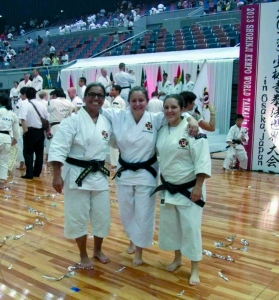
What motivates you the most and deceives you today?
What motivates nationwide is to give training and training, to provide differentiated training experiences, and to motivate kenshi to a continuous practice that stimulates and deepens the curiosity to learn. To participate directly or indirectly in their training as a person, to enhance their social capacities.
Being at international events to share the practice and socializing with friends from other countries, some are long standing, people that make us feel good, and that somehow enrich us as individuals.
Being able to train with masters who overflow knowledge, and realize that we can be training in a dojo with five Japanese masters and each one performs in their own way, while being correct, are different, which promotes a huge amount of stimuli, which allows a differentiated learning, but I cannot fail to say that when you are in space those that I consider as examples of a life, the focus is only one (laughs).
It is often commented that “it was once different”. What are the main differences between the years 1980/1990 and today?
A small example, it would be impossible for someone to dare to enter a dojo without greeting, adults, children, there was a sharper deference regarding training protocols, it seems to me that some rules are being forgotten or little reinforced, there were other things which today would be a huge accomplishment, the technical knowledge, training methodology, effort physiology, changed from day to night, which enhanced learning, which for me what has changed, were the people, the interests, the goals with which goes to a dojo, societies are evolving, and people too, the interests of the new generations has been changing, often the going to a dojo arises as a necessity, and less for taste.
The concern with training units, pedagogy, the differentiation between children and adults, made the training different, less intense and more scientific and adequate.
Not everything that was done was correct, but relative to the rules within a dojo, was not observed so much “relaxation”.
What was the most demanding (hard) exam to date? And why?
The exam for 4th Dan … It started very warm and began to move me with the liver and in that moment I decided that I would put the soul in everything that was going to do was realized in France, I know that when I was finishing the embu technician, in the last technique, just said to myself hold your arms up, keep your arms up. When I finished, I had to tell the brain to put one leg in front of the other to sit and not fall.
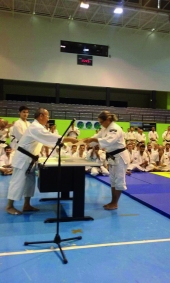 Do you feel that the philosophical component is increasingly “forgotten”? Would it be important, at all, to include in the training program?
Do you feel that the philosophical component is increasingly “forgotten”? Would it be important, at all, to include in the training program?
It does not seem to me that philosophy has to have a specific period of time, it has to be intrinsically linked to all the training, it has to go hand in hand with the technique, with the exception of some more specific questions, the teachings have to be Complementary, philosophy begins the moment you arrive at the dojo and put your shoes aligned and tidy.
How do you see the future of Shorinji Kempo in Portugal? And worldwide?
The future of Shorinji Kempo goes through what I answered earlier, if no more dojos are opened, it will be difficult to predict a sustained future for the national Shorinji Kempo, Shorinji Kempo has been in Portugal for 43 years and we have 10 associations, for me it is an alert red for the future 3rd dan, who could be Master of Branch, who for me with the graduation of 2nd Dan are at most assistants of a master, are at this moment seven, and that I believe that soon will be nine; would potentially be nine new associations, which would add about one hundred kenshi to the national Shorinji Kempo and greater expression. Or people definitely assume that having graduation is also to serve the Shorinji Kempo, or we will eventually exhaust ourselves in the groups that exist.
What goals have you set for yourself in the short term?
Continue to promote the Shorinji Kempo, continue to train, and who knows get into Senior Taikai (laughs)
How do you see yourself ten years from Shorinji Kempo?
I hope to continue to train with the same will, to continue to help people learn, to share experiences that motivate new kenshi, but above all to maintain the passion and convictions that have kept me in Shorinji Kempo for 39 years.
What are your friendships across the borders within Shorinji Kempo? (those people with whom you had experiences or achievements that marked you).
They are some as I have said, it would not be correct for me to speak in names and not to mention all would be impolite, I can say that they are from many countries, with whom I train and receive, knowledge, positive energies and great joy, people with whom I fraternize and make you feel good.
What advice would you like to give to all kenshi?
Train with the heart, be genuine in your actions, promote harmony in the dojo, be convinced of your actions, share the Shorinji Kempo, and lead it into your daily life.
Be happy.

